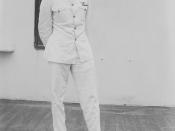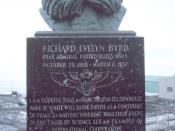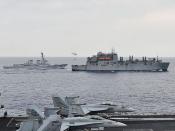Richard Evelyn Byrd was born in Virginia in 1888. He joined the United States Naval Academy at the age 20 and joined the navy in 1912. He learned to fly in World War I during his tour with the United States Navy. He became an expert in flying and was appointed to plan the flight path for the US Navy's 1919 transatlantic crossing.
On May 9, 1926, Byrd and Floyd Bennet attempted a flight over the North Pole. They claimed to have completed the trip but evidence from their diaries has placed doubt on their claim. Even though the made enough money for Byrd to explore the South Pole.
In 1928, Byrd began his expedition in Antarctica. A base camp was setup on the Ross Ice Shelf. Scientific expeditions by dog-sled, snowmobile and airplane began. Photographic expeditions and geological surveys were done during summer. After the first winter, expeditions resumed and on November 29, 1929 the flight to the South Pole was launched.
Byrd flew the Floyd Bennet to the South Pole and back in 18 hours and 41 minutes. After further exploration, the expedition returned to America on June 18, 1930.
Byrd went on three more expeditions to the South Pole from 1933-1935 and 1930-1941, taking part in Operation High Jump from 1946-1947, the largest Antarctic expedition to date. Byrd also commanded Operation Deep Freeze which made permanent Antarctic bases at Mc Murdo Sound, the Bay of Wales and the South Pole in 1955.
Richard Byrd died on March 12, 1957. He had got twenty-two awards and special awards, nine of them were for bravery and two for heroism for saving the lives of others. He also earned the Medal of Honour, the Navy Cross, the Congressional Life Saving Medal, the Distinguished Service Medal and the Flying Cross.


